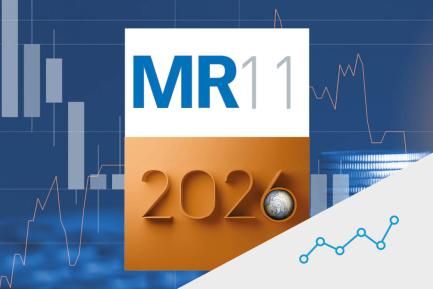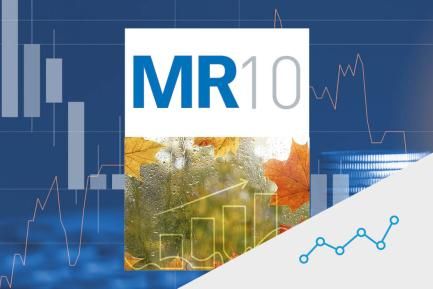
Financial turbulence shakes, but does not stifle, the markets and central banks
In March, the markets experienced their third big movement so far this year. Whereas January was marked by a slowdown in inflation and renewed risk appetite, which was reversed in February due to the persistence of the cycle and prices, in March the collapse of Silicon Valley Bank in the US triggered a brief but intense episode of panic.
Financial markets survive the first materialisation of risks associated with the rate hikes
In March, the markets experienced their third big movement so far this year. Whereas January was marked by a slowdown in inflation and renewed risk appetite, later reversed in February due to the persistence of the cycle and prices, in March the collapse of Silicon Valley Bank (SVB) in the US triggered a brief but intense episode of panic. Interest rate expectations thus ended the quarter at the same level as in mid-January – albeit due to very different reasons – with lower terminal rates which are also expected to be shorter lived on both sides of the Atlantic. On the other hand, US sovereign 2-year paper experienced its biggest rally in the past 35 years following the collapse of SVB, with yields falling more than 130 bps in just a week. This volatility was not so pronounced in the stock markets, where the setbacks were concentrated in banking stocks and other sectors highly exposed to interest rates (already corrected in large part in Europe). Commodities, weighed down by weak demand in recent months, also suffered as a result of the instability.

A lower and shorter-lived terminal rate
The global upturn in risk aversion triggered exceptionally high volatility in interest rate expectations in March. At the beginning of the month, the persistence of inflation and the resilience of economic activity led the market to anticipate terminal rates of 4.25% in Europe and of up to 5.75% in the US. However, the collapse of SVB and the sale of Credit Suisse led to a sharp reversal of these movements. The implicit money market rates thus went from anticipating rate rises of up to 175 bps and 100 bps in Europe and the US, respectively, to even anticipating rate cuts towards the summer in the case of the Fed. After the panic subsided, the ECB raised rates by 50 bps at its March meeting, bringing the depo rate to 3.0%, although it opted to omit any kind of forward guidance. The Fed also raised rates by 25 bps, albeit signalling that the end of the rate hike cycle was near. At the end of the month, greater inertia in the European inflation data once again pushed up interest rate expectations, placing the ECB’s anticipated terminal rate at 3.5%, while US expectations continued to anticipate a final 25-bp rise in May for the Fed.

Sovereign debt yields slump and trigger an episode of high volatility
The volatile interest-rate expectations also dragged down public debt yields on both sides of the Atlantic, particularly in the case of shorter-term bonds. The yield on the 2-year German sovereign bond, which reached its peak since the financial crisis at around 3.3% at the beginning of the month, fell more than 100 bps with the Credit Suisse affair, before later recovering some 40 bps once the markets had digested the ECB’s rate rise and the turbulence had been left behind. Even more intense was the drop in the US 2-year benchmark which, in the midst of its biggest rally since 1987, lost 130 bps versus its peak of 5% at the beginning of March. Consistent with an imminent end to the Fed’s rate hikes, the recovery in 2-year rates over the past week has also been less pronounced, at around 25 bps. The longer-term benchmarks (10 years), meanwhile, fell around 65 bps in the month. US sovereign bonds have been their most volatile since 2008, and this caused a sharp deterioration in market liquidity and financial conditions, until the Fed’s decision to open up a new discount window where T-bills can be discounted at par value eased tensions. This move, which was coherent with the fact that the instability was triggered by SVB’s poor management of the rate hikes, did not result in any contagion in the equity markets, although there was some contagion in the currency markets, which are heavily driven by interest rate spreads.

Global stock markets close up for a second consecutive quarter despite the volatility
n March, the main stock market indices closed their second consecutive quarter in the green, a sign of the gradual – and not always linear – recovery in risk appetite as the cycle of rate hikes approaches its end. In March, although the stock markets did not suffer as sharp an episode of volatility as the sovereign debt markets, the stocks most exposed to rates did experience significant movements. The banking sector was particularly affected, with the biggest falls (–30%) occurring in smaller US banks, which found themselves at the epicentre of the episode of instability. Taking into account the bigger banks, however, the declines suffered in the month by banking stocks as a whole were smaller (around –20%), both in Europe and in the US. In the case of Europe, this fall occurred on the back of a rally since the summer of +40% in the banking stocks of the Stoxx600 index, while the rebound in the final week of the month was also greater (+6.5%). Accordingly, the national indices with the greatest presence of the banking sector, namely the IBEX 35 and the Mib, benefited both from the rally at the end of the month and from the strong performance of banking stocks over the last two quarters. The Nasdaq100 index of US tech companies also benefited from the expectations of a lower and shorter-lived terminal rate, registering gains of +12% in March.


Weak global demand hampers commodity prices
Commodity prices experienced a month of declines. The price of the Brent barrel registered its fifth consecutive month of losses, although it managed to recover to the 80-dollar mark after falling to a 15-month low (73 dollars) at the height of the volatility. In addition to the obstacles for refinery supplies generated by the strikes in France and the interruption of production in Iraq, OPEC made a surprise announcement to cut production by 1.16 million barrels a day (mbd) between May and the end of the year, in addition to the cuts of 2 mbd already announced in November. The price of European natural gas (the Dutch TTF) also fell and traded between 40 and 50 euros/MWh thanks to the high level of reserves in Europe (the highest for this time of year in more than a decade). In addition, the EU approved the extension of the voluntary emergency measures to cut gas usage by 15% until 31 March 2024, and it plans to expand the bloc’s capacity to receive liquefied natural gas by almost a third next year. However, aspects such as the expected increase in the demand for gas from Asia beginning in the summer, as well as the attractiveness of gas at these prices as opposed to coal or oil for some power plants and industrial users, supported the recovery of futures prices above 50 euros.



